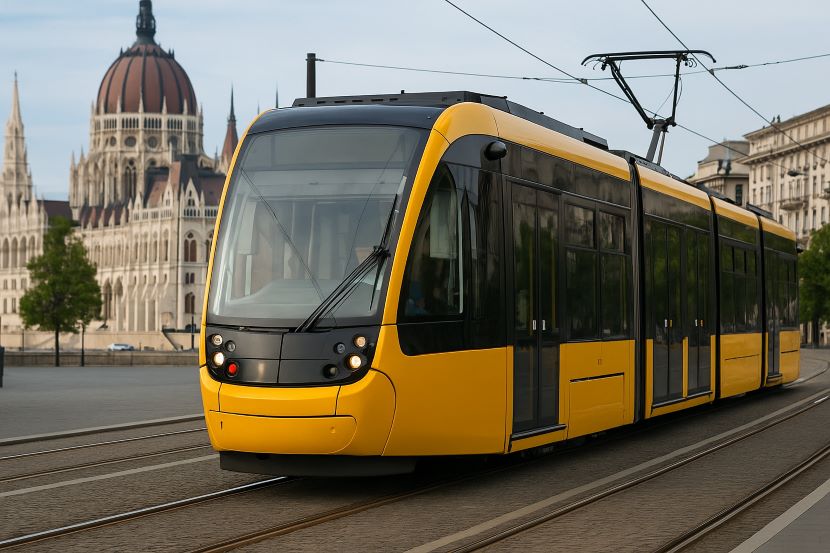Budapest Public Transport Strengthens with New Accessible CAF Trams
Budapest strengthens public transport with 51 new EU-funded CAF trams, improving accessibility, efficiency, and passenger comfort
Budapest is receiving more trams thanks to the EU and the Hungarian state, which is helping to finance the acquisition of the new trams. The Budapest Transport Centre (BKK) and the Ministry of Public Admininstration and Regional Development received more than 54 billion HUF to purchase 51 new CAF trams. This assistance proves the Government of Budapest is working on achieving a modern, sustainable, and inclusive transport system.’
This project is part of Hungary’s sustainable transport development strategy, which is aligned with EU cohesion policies emphasizing clean, accessible, and lower-emission transport. The addition of the new low-floor trams will increase the share of accessible barrier-free services in Budapest from 30 to 40 percent by 2026.
Details of the CAF Tram Order
Budapest ordered the new CAF vehicles in two stages: November 2022 and March 2023. These orders used the final options available under a framework contract first signed in 2014 and extended in 2021.
The package includes 46 shorter trams and 5 longer units, designed to serve both high-demand and mid-capacity routes across the city. The Spanish manufacturer CAF has already delivered 20 vehicles, which are now running in passenger service. Deliveries will continue in phases until late 2026, ensuring a gradual but consistent rollout of modernized vehicles.
Features of the New Trams
The low-floor CAF trams meet the latest European standards for urban mobility. Key features include:
- Full accessibility for passengers with reduced mobility, parents with strollers, and older travelers.
- Air-conditioning to improve comfort during Budapest’s hot summers and cold winters.
- Energy-efficient design with regenerative braking and modern propulsion systems.
- Spacious interiors that provide greater standing capacity and smooth passenger flow.
By combining passenger comfort with advanced energy technology, these trams directly contribute to Budapest’s goal of reducing emissions and enhancing the appeal of public transport.
Routes Already Using New CAF Trams
The newly delivered vehicles are already operating on several of Budapest’s busiest tram lines. Current deployments include lines 1, 3, 17, 19, 42, 50, 56, 56A, and 61, which serve both inner-city neighborhoods and suburban connections.
The choice of these lines reflects a strategy to introduce low-floor vehicles where they can benefit the greatest number of daily commuters, students, and visitors.
Planned Expansion Across More Tram Lines
BKK and Budapest’s public transport operator BKV are preparing further infrastructure upgrades, including improved power supply systems and extended termini, to accommodate the next wave of CAF trams. Once these works are completed, modern vehicles will also be introduced on lines 2, 23, 24, and 62.
In addition, plans are being studied to expand low-floor operations on lines 14 and 69, and feasibility reviews are underway for possible future deployment on 47 and 49, which are central and heavily used routes.
Broader Impact on Budapest’s Transport Network
The tram expansion is part of a wider policy to shift more journeys to sustainable modes of transport. With Budapest’s growing population and tourism demand, efficient public transport is essential to reducing congestion and lowering environmental impacts.
The funding also highlights the role of the European Union in modernizing Hungary’s capital city. By investing in tram services, the EU strengthens cohesion objectives while ensuring long-term resilience in urban mobility.
Travel Guide for Tram Users
For travelers visiting Budapest, the introduction of new CAF trams means a more comfortable and accessible way to explore the city. Visitors can expect:
- Easier boarding thanks to step-free low floors.
- Cooler rides in summer with modern air-conditioning.
- Direct access to major attractions, including Buda Castle (via tram 19), Margaret Island (via tram 4–6 interchange), and the Parliament area (via tram 2 once upgrades are complete).
Tickets for trams are available through BKK ticket machines, mobile apps, and at key metro and tram hubs. Travelers can use single tickets, travel cards, or passes valid across all public transport modes in Budapest.
The trams run at frequent intervals, making them one of the most efficient ways to move between key landmarks and neighborhoods.
Conclusion
The expansion of Budapest Tramline CAF is directly linked to developing a new cleaner and efficient form of transport. By 2026, over 50 new trams will come into service which will help the city gain prominence within the EU for sustainable mobility. EU and national funding will further support Budapest’s ambition to improve urban mobility. Budapest residents and tourists will enjoy the new trams which will make their journeys across the city, faster, and more comfortable.
The post Budapest Public Transport Strengthens with New Accessible CAF Trams appeared first on Travel and Tour World


Comments and Responses
Please login. Only community members can comment.